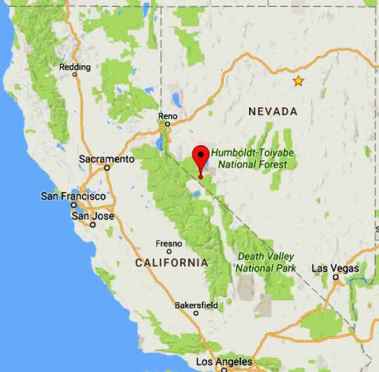El Servicio Geológico de los Estados Unidos borró información de explosión realizada el día anterior en Nevada
Un fuerte sismo de magnitud 5.5, dada su escasa profundidad, sacudió a Nevada, cerca del límite con el estado de California, al cual siguieron una serie de temblores que hacen temer a muchos la proximidad de un gran terremoto.
El sismo, ocurrido a las 08:18:00 GMT de hoy, tuvo epicentro ubicado en el continente, 26 kilómetros al suroeste de Hawthorne, Nevada, con hipocentro a sólo 8.6 kilómetros de profundidad, según el Servicio Geológico de los Estados Unidos (USGS).
Aunque la zona del epicentro tiene escasa población, el sacudón se sintió fuerte en Sacramento, la ciudad más importante cercana, al cual siguieron, con diferencia de minutos, una serie de sismos más, el más fuerte de magnitud 5.6, según informan varios medios de los Estados Unidos.
¿Fueron causados por explosión nuclear?
El día de ayer el USGS registró una explosión (nuclear) en Nevada, que causó un temblor de magnitud 2.7, 320 kilómetros al noreste del epicentro de este sismo. Curiosamente, hoy el USGS borró este registro en su web. Sólo queda este rastro en caché de Google, que también desaparecerá en los próximos días:
Para diversos científicos, las pruebas nucleares no sólo desatan sismos, sino que pueden conducir a un desplazamiento de los polos, por lo cual lanzan advertencias y recomiendan se estudie esta correlación, como lo dice en este artículo del profesor Gary Whiteford, de la Universidad de New Brunswick, quien pone como ejemplo sismos que sucedieron poco después de pruebas nucleares en Nevada, a 283 kilómetros del punto de explosión:
Nuclear bomb testing has doubled the earthquake rate.
Gary Whiteford, Professor of Geography, University of New Brunswick
Abnormal meteorological phenomena, earthquakes and fluctuations of the earth's axis are related in a direct cause-and-effect to testing of nuclear devices.
Shigeyoshi Matsumae, President Tokai University Yoshio Kato, Department of Aerospace Science
On June 19, 1992, the United States conducted an underground nuclear bomb test in Nevada. Another test was conducted only four days afterwards. Three days later, a series of heavy earthquakes as high as 7.6 on the Richter scale rocked the Mojave desert 176 miles to the south. They were the biggest earthquakes to hit California this century. Only 22 hours later, an "unrelated" earthquake of 5.6 struck less than 20 miles from the Nevada test site itself. It was the biggest earthquake ever recorded near the test site and caused one-million dollars of damage to buildings in an area designated for permanent dispoasal of highly radiocative nuclear wastes only fifteen miles from the epicenter of the earthquake. Although the quake provoked renewed calls for a halt to plans for storing radioactive materials in such an unstable area, the larger questions have still not been raised in the United States: Do bomb tests actually cause earthquakes? Do nuclear tests make the planet more prone to geologic disruption?
Understandable Unease
The latest (and apparently continuing) earthquakes in California and Nevada suggest an inquiry by U.S. scientists may be long overdue, and could lead to an examination of studies over the past twenty years from scientists in Britain, Germany, Japan and Canada, warning that nuclear tests are weakening the earth's crust, triggering earthquakes and causing the earth's pole to shift.
In a statement on July 14, 1992, responding to "understandable unease", the Department of Energy in Washington asserted the relationship between nuclear testing and earthquakes is "nonexistent." Yet common sense would suggest the cumulative effect of so may nuclear tests around the world would leave the planet at least somewhat shaken. Indeed in 1956, Estes Kefauver, then Democratic Vice-Presidential candidate, warned, "H bomb tests could knock the earth 16 degrees off its axis!" He was simply ignored.
However, in a study twenty years later by two Japanese scientists, entitled Recent Abnormal Phenomena on Earth and Atomic Power Tests, Shigeyoshi Matsumae, President of Tokai University, and Yoshio Kato, Head of the University's Department of Aerospace Science concluded:
Abnormal meteorological phenomena, earthquakes and fluctuations of the earth's axis are related in a direct cause-and-effect to testing of nuclear devices. . . . Nuclear testing is the cause of abnormal polar motion of the earth. By applying the dates of nuclear tests with a force of more than 150 kilotons, we found it obvious that the position of the pole slid radically at the time of the nuclear explosion. . . . Some of the sudden changes measured up to one meter in distance.
Not quite Kefauver's 16 degrees off the axis; but not entirely reassuring either. Two years later, on 12 October 1978, the British New Scientist reported:
Geophysicists in Germany and England believe the 1978 earthquake in Tabas, Iran, in which at least twenty-five thousand people were killed, may have been triggered by an underground nuclear explosion. . . . British seismologists believe the Tabas earthquake implies a nuclear test that has gone awry. . . . Moreover, a seismic laboratory in Uppsala, Sweden, recorded a Soviet nuclear test of unusual size--ten megatons--at Semipalitinsk only thirty-six hours before. . . . One German scientist specifically implicated this test in the origin of Tabas disaster.
More recently, on 14 April, 1989, at the Second Annual Conference on the United Nations and World Peace in Seattle, Washington, Gary T. Whiteford, Professor of Geography at the University of New Brunswick in Canada, presented the most exhaustive study yet of the correlation's between nuclear testing and earthquakes. In a paper entitled Earthquakes and Nuclear Testing: Dangerous Patterns and Trends, Whiteford presented alarming conclusions which to this day have remained almost completely ignored in the United States, although the paper has been widely translated and published abroad.
Whiteford studied all earthquakes this century of more than 5.8 on the Richter scale. "Below that intensity," he explained, "some earthquakes would have passed unrecorded in the earlier part of the century when measuring devices were less sensitive and less ubiquitous. But for bigger quakes the records are detailed and complete for the entire planet." So Whiteford was able to make a simple comparison of the earthquake rate in the first half of the century, before nuclear testing, and the rate for 1950 to 1988. In the fifty years before testing, large earthquakes of more than 5.8 occurred at an average rate of 68 per year. With the advent of testing the rate rose "suddenly and dramatically" to an average of 127 a year. The earthquake rate has almost doubled. To this day the U.S. military attributes the increase to "coincidence." As Whiteford comments, "The geographical patterns in the data, with a clustering of earthquakes in specific regions matched to specific test dates and sites do not support the easy and comforting explanation of `pure coincidence.' It is a dangerous coincidence."
Within the data he found other suggestive patterns. The one-two nuclear test punch that preceded by only a few days the July earthquakes in California this year may reveal a special danger. The largest earthquake this century took place in Tangshan in North-East China on July 27 1976. It measured 8.2 and killed 800,000 people. Only five days earlier the French had tested a bomb in the Mururoa atoll in the Pacific. Four days later the United States tested a bomb in Nevada. Twenty-four hours later the earthquake hit China.
Killer Quakes and Bomb Tests
In an even more revealing analysis, Whiteford studies so-called "killer earthquakes" in which more than one thousand people have died. He compiled a list of all such quakes since 1953 and matched them with nuclear test schedules. Some test dates were not available, but in those that were, a pattern was evident: 62.5% of the killer earthquakes occurred only a few days after a nuclear test. Many struck only one day after a detonation. More than a million people have now died in earthquakes that seem to be related to nuclear tests. Again, the governments of the nuclear nations claim the results are mere coincidence. Officially the U.S. energy department maintains that even their most powerful nuclear tests have no impact beyond a radius of 15 miles. The claim is challenged by the instruments of modern seismology that can register nuclear tests anywhere in the world by measuring local geological disruptions. Whiteford speculated that although the reverberations may fade within fifteen miles of a test, they are merely the first ripple of a wave that travels through the planet's crust and spreads around the globe.
In 1991 the Nuclear Age Peace Foundation published Whiteford's findings in an article called "Is Nuclear Testing Triggering Earthquakes and Volcanic Activity?" In an interview with California State seismologist, Dr. Lalliana Mualchin, the foundation went on to inquire into the long-term effects of testing. Mualchin was asked if the cumulative effect of nuclear testing might be to trigger earthquakes and volcanoes. He replied, "A single nuclear test may have little effect on the earth, like that of an insect biting an elephant. But the cumulative effect might move the earth's tectonic plates in a manner similar to how a swarm of insects might start an elephant running." Mualchin added, "If an insect bites an elephant in a sensitive spot, such as an eye or an ear, then there might be a vast movement out of all proportion to the size of the bite." The article concluded, "Who will the world hold responsible if suddenly an unprecedented series of violent earthquakes and volcanoes shake the earth? Will nuclear testers be able to assure the world they were not responsible?"
Ten More Years of Tests?
Recent decisions announced by the Bush administration to "limit" tests in size and number for five years are meaningless. They represent little or no change from what in fact has been the practice for the last several years. They avoid dealing with the mounting call by Congress and the world--through the UN--for a halt by all nations to all testing forever. According to UPI, President George Bush will actually veto any effort to halt testing. Bush says he wants testing to continue "for at least ten years" to check the safety and reliability of nuclear bombs. The Russians and the French no longer feel the need to conduct such "checks," and have halted testing altogether. Why cannot the USA?
However, as the next presidential election nears the prospect emerges of finally ending fifty years of bomb tests. Governor Bill Clinton's office says he supports a comprehensive nuclear test ban. His running-mate Al Gore is one of the supporters of the Congressional call for a one-year moratorium on nuclear testing.



